
PRODUCTION
Principal photography lasted from May-July 1984, with last minute insert shots completed in September 1984. The first day of shooting was for the scenes of the Colonel's Mansion in Palos Verdes Peninsula. Jon Terry, from the Boston stage circuit was cast as Glover, the Colonel in San Diego, and Cathleen Cordell as his wife, struck Dan O’Bannon as a Pat Nixon lookalike.

The first two weeks were spent in the "Resurrection Cemetery",
actually a modified olive grove in Sylmar about 30 miles north of Los Angeles,
California. One hundred mushrooms were created, grass was grown for the grove
and spagnum moss was added to olive trees for that ‘Kentucky in summer’
look.
Tombstones of all types were rented from every studio in Los Angeles, in addition to the 300 Stout designed. Some of these bore actual family names from his wife, who happened to be from Louisville, where the story takes place. The famous weeping angel monument subsequently was rented to at least six times to other motion pictures! To create that aged effect, Stout ingeniously plastered sawdust all over the foam tombstones.
The cemetery gates (including
the foam gateway arch) were built by Applied Entertainment, who specialized in
theme park animatronics. Unfortunately they went bankrupt a week into production
and Stout's art dept. picked up from there.
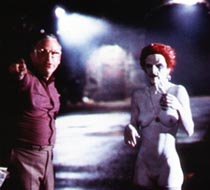
Makeup artist Bill Munns was told to construct an appliance for Linnea Quigley to wear over her pubic area, to achieve a "Barbie doll" effect. Trash was to be played by Jewel Shepard originally but she didn't want to do the strip scene. In Invasion of the B-Girls, Jewel Shepard recounted how she met Dan and got the role as Casey. "He knew I was working in a strip joint and he used to say to me, 'Jewel, one of these days I will get you out of there and give you a part in a movie if I ever get that chance.' And he was true to his word. I think I did seven auditions. Dan said to me, 'I'd like you to play the role of Trash...you'd have to take off all your clothes.' He figured I'd have no objection to that but I said 'Dan, I just can't. I've done topless things my whole life. I want to have my clothes on.' And he said 'Okay, there's this punk role I'm writing, would you like to play that?' I had worked with so many directors who were more like traffic cops. working with Dan was so much better. He made me feel like an actress."
It was this topless role that ended up making someone a star however. Linnea Quigley, also an aspiring actress in her mid-20's, snatched it up and became a B-movie "scream queen". To date she has appeared in over 80 films. "I think it was the second week, the only day they didn't have rain machines, and it was really humid. I'd just done my tombstone dance and it was six in the morning...I remember practically passing out. Somebody had to drive me home!"

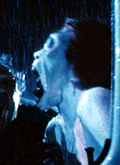 For closeup chomp scenes, an
exaggerated jaw was built up for Linnea to wear.
For closeup chomp scenes, an
exaggerated jaw was built up for Linnea to wear.
The first corpse that rises up was a skeleton Munns animated that was placed in
a 2x2x4 box. When Stout first saw this ‘effect’ he thought it was something
Munns had started, not finished! Dan was not pleased and made it clear he
needed better effects very soon or else…
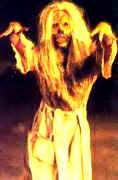
"While I was making the film I kept pounding myself in the head. I'd say
'Other people get Rick Baker--why didn't I?'...We had to redo some of the
corpses. We got the ones that are featured prominently looking good. It came off
better than I had a right to expect, considering our schedule and the money we
had." (Cinefantastique)
The third week took place at the fictitious "Uneeda Medical Supply".
Exteriors were shot at an unused warehouse in downtown Burbank, California.
Basement and stockroom interiors were sets built by Stout in L.A. What appears
to be the basement of the place was actually a stairway towards the roof balcony
of one building.
Dan envisioned 2,4,5 Trioxin not just as a chemical but as a character,
following the vapor’s progress throughout the film. Cast as this lethal gas
was yellow sulfur, which produced an overwhelming stench and quite a few
headaches for cast and crew.
Stout cut butterfly pictures out of a book and blow-dryed them on their mount. The split dogs were created by Tony Gardner. Dan wanted bigger dogs, but had to accept Labradors.

The Tar Man's design was inspired by the mummified people found in tar sands
from prehistoric Wales. The graveyard zombies were inspired by the Mummies of
Guanjuanato, Mexico. In that village, corpses were kept in all stages of decay.
The Tar Man was played by puppeteer Allan Trautman, who at 6'2" and 150
lbs. was a perfect walking corpse, swaying and lurching like no zombie ever did
before. Trautman was fitted with black leotards over which polyurethane bones
and melted strands of flesh were attached.
More warehouse scenes including
the cylinder reach were shot during week four. The meltdown scene was created
with a wax sculpture of a mummified body, then superimposed with the sulfur. The
glass breaking was not intended – that was a happy accident. James Karen had
been so enthusiastic about his role as Frank, the store manager, that he would
often visit the set to oversee scenes he wasn’t even in that day! One of the
most memorable visits for the cast and crew was when Karen brought [the late
great] Jason Robards with him.
The yellow cadaver prop was created by Bill Munns but his headless suit was so
badly done that O'Bannon is forced to fire Munns immediately. Kenny Myers
replaced him, redesigning some of the Munns props. It was because of Myers’
insistance that Munns' name was retained in the credits. Meanwhile, O'Bannon
tried to hide the imperfections of the numerous Munns background masks by
minimizing the close-ups and showing ghouls mainly through windows.
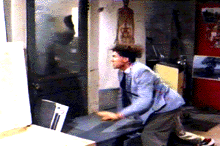
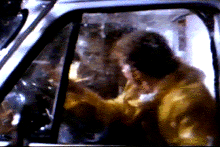
"I fired his ass, the useless goddamn son-of-a-bitch!" Dan revealed to Cinefantastique. "If I had been the producer I would have sued for fraud. You may have noticed that the revived corpses in the cemetery did not get too much prominence. If I had shown too much of them you would have realized what lousy pieces of work they were....everything resembled those $30 halloween masks you can buy at the local toy store. They weren't prosthetics, they were head pullovers and you could see every flaw such as gaping eyeholes."
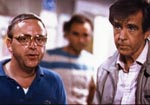 The
pressure was getting to O’Bannon. Near the end of the shoot he developed a
nervous twitch and often had heated arguments with cast particularly Clu Gulager,
who explained to Fangoria that "the tension on the set was getting
pretty high. This was Dan's first directing job and he was getting suggestions
from somebody every time he turned around. We were also running a bit behind
schedule which didn't help things. We were doing this very emotional scene where
I was doing a lot of ranting and raving and there was a disagreement between Dan
and myself on how the scene should be played. I blew up at him and we had a few
rough moments." Dan was very happy with the end results of Clu’s
performance as Burt Wilson, the storehouse manager; even though he’d been cast
practically hours before the first day of shooting. "Everything got back to
normal and Dan and I are talking again but I really regret that it
happened."
The
pressure was getting to O’Bannon. Near the end of the shoot he developed a
nervous twitch and often had heated arguments with cast particularly Clu Gulager,
who explained to Fangoria that "the tension on the set was getting
pretty high. This was Dan's first directing job and he was getting suggestions
from somebody every time he turned around. We were also running a bit behind
schedule which didn't help things. We were doing this very emotional scene where
I was doing a lot of ranting and raving and there was a disagreement between Dan
and myself on how the scene should be played. I blew up at him and we had a few
rough moments." Dan was very happy with the end results of Clu’s
performance as Burt Wilson, the storehouse manager; even though he’d been cast
practically hours before the first day of shooting. "Everything got back to
normal and Dan and I are talking again but I really regret that it
happened."
Burt’s nephew Freddy, played by Thom Mathews, resembled a sort of young Paul Newman to the producers. He had his ear pierced especially for the role, part of his method approach to acting. "Dan and I got along real well, but I may have been the only one who did. Somehow he and I have remained friends. Watching Clu and Jim work was a real education for me. They are both very versatile actors and because Return was both a horror film and a comedy, it allowed me to see that much more of what they could do." (Fangoria).
Week five was spent at the "Resurrection Funeral Home", a mortuary set
built by Stout as well, decorated in an early 20th century German style. The
place was to belong to one Ernst Kaltenbrunner played by Don Calfa, who
incorporated a Nazi background into the character. One of the pictures in the
background belonged to a friend of Don's who collected WW1 German paraphernalia.
Don also proposed adding jars of gold fillings in the attic.
O’Bannon took the name straight from an infamous Nazi war criminal. The real Ernst Kaltenbrunner (born in 1903 in Austria) was an anti-semite, relishing his rank as SS Chief of Intelligence between 1942-45. He supervised the Gestapo and concentration camps, endorsing the use of lethal gas to liquidate the Jews. He was captured by U.S. troops in 1945, indicted in Nuremberg trials and sentenced to hanging in 1946.
When we first meet Ernie he is listening to a Nazi anthem, "Panzer Rollen in Afrika Vor". This recording was on a tape O’Bannon had called Panzer Marches Volume One. One scene that confuses many ROTLD fans is the phrase Ernie ad libbed as the rains storm down out the window of his mortuary: "It's coming down like an eindringend soldatisch" (loosely translated to 'an infiltrating brigade of soldiers’). The script called for a Luger pistol, but they went with another German weapon – a Walther P-38.
The crematorium was brass-plated with a interesting inscription. Hill and Giler Furnace Type. This was the director’s spiteful reference to some enemies – producers Walter Hill and David Giler - who re-wrote his 1979 Alien script and gave O’Bannon less credit than he deserved.
A 22 year-old makeup artist named Tony Gardner, who had been Rick Baker's protege on Michael Jackson's Thriller (and the zombie in the video whose arm falls off) was brought in at the recommendation of actor Brian Peck, to do the half corpse and split dog. O'Bannon wanted the lady to be wearing a nightgown originally but got a look at her decayed breasts underneath and knew he had to show them off. Stout pumped 'spinal fluid' onto the table out of her spine as Gardner operated the torso off-screen. The bright blue eyes and tongue were O'Bannon's request. Myers' 'kabuki' makeup on Freddy after he is zombified and acid-scarred was also exaggerated to O'Bannon's liking; he preferred the puffiness to the eaten away look. Also Drew Deighan takes over the role of a paramedic after a previous actor friend of Tom Fox's just couldn’t nail the lines after numerous takes.
Frank (James Karen) committing suicide was Karen’s idea as he told Deep Red. "Originally when I run out of the chapel, I was supposed to escape out a window and join the rest of the zombies. Although I was tempted to join them and hang around Linnea Quigley for all eternity, I suggested that my character commit suicide and then Dan worked it out. "Dan's a very complicated man and has, I would say to his face, a lot of enemies. I liked O'Bannon's direction a lot and the material and everything combined to inspire me. He's not the easiest man to work with but it was very exciting. He has an inner intensity, a brilliance."
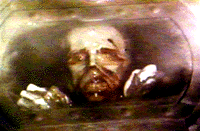

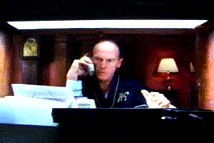
Week 6: The scene of the Colonel on the phone with the general seen from inside
the console in the living room was actually impossible to get from the actual
console prop itself. So they shot it in the Resurrection set by painting the
walls red and furnishing it to look like the mansion. Close-up insert shots
including Suicide's bite (originally Dan wanted a fountain of blood),
paramedics' brains (calf brains) and Freddy's foaming Alka Seltzer mouth.
Optical effects were filmed like the Tar Man meltdown and the crematory vapors
entering the atmosphere. The "ant farm scene" where a corpse played by
Brian Peck, is seen crawling through the ground as if in cross-section, was a
good idea but didn't quite come out right to O'Bannon. Other experiments were
not successes to the director either but could not be re-done: Tina walking all
alone in an aerial wide shot for instance, rather than from the ground, didn't
quite work as suspenseful as Dan would have liked.
The film is edited as it is shot, with slow motion effects being utilized to
drag the running time out more. The score was re-edited to O'Bannon's dismay to
give the film a punk rock edge. The original theme was actually given to them by
British composer Francis Haines.
With rapid shots borrowed from The Birds, and pacing out of a Howard Hawks movie, Dan calls The Return of the Living Dead's look "very pretty but not a style that I ever thought I would shoot in" likening it to of all things, Disney's colorful Song of the South. "But I wasn't the director of photography, so it was his choice. The movie tends to look like a scaled-down kind of Spielberg picture-that kind of big, glossy look. It's not an effects-heavy movie, thank God. It's plot-action-character-thriller-horror-comedy." (Cinefantastique)